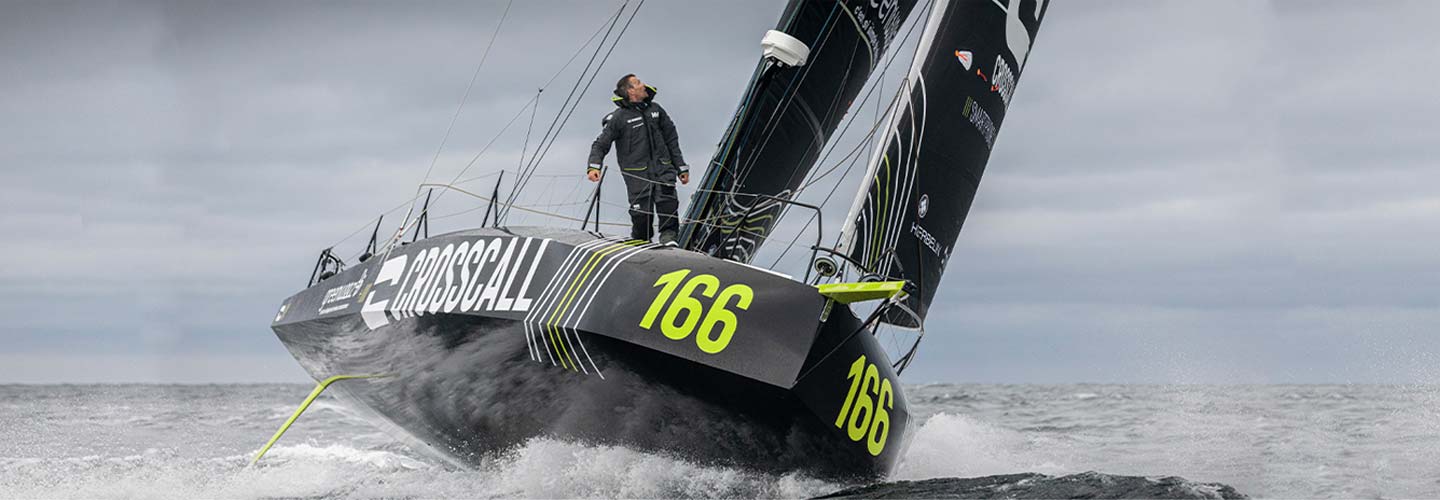LE PREMIER CLASS40 EN FIBRE DE LIN
3 Novembre 2022

Les fibres, tissus, résines époxy et adhésifs de Sicomin ont été utilisés par Grand Largue Composites (GLC) pour construire le premier voilier de course Class40 doté d’une quantité importante de renforts en fibres de lin.
Le yacht, appelé Crosscall , a remporté les championnats du monde de Class40 en juin 2022 et est un prototype du nouveau design Lift V2 de Marc Lombard, l’un des principaux architectes navals dans ce domaine.
La Class40 est l’une des flottes les plus compétitives de la course à la voile. Les coques des yachts Class40 doivent être légères, solides et rigides, et durables dans les conditions les plus extrêmes. De plus, pour limiter les coûts, ils ne peuvent pas être renforcés avec des fibres de carbone. La qualité et la fiabilité des résines utilisées pour l’infusion et le laminage des coques sont donc primordiales.
Le propriétaire de Crosscall , Aurélien Ducroz, tenait à utiliser le plus de lin possible dans la construction du yacht, mais Lombard – qui devait certifier et garantir la structure du bateau en course au large – était plus prudent. Il a donc fallu trouver un compromis.
Le cockpit de Crosscall a été conçu pour être efficacement non structurel, avec l’écoute de grand-voile, qui peut générer d’énormes charges de choc, supportée séparément. Cela permettrait de réaliser le cockpit à partir d’un tissu hybride biaxial composé à 50% de fibres de lin. Les autres parties du bateau qui incorporent de la fibre de lin comprennent le tunnel, le capot moteur, les ballasts et le capot. Le reste du bateau est renforcé avec des tissus 100% fibre de verre.
Pour l’aider à réaliser cette conception ambitieuse, GLC, un spécialiste de l’infusion hautement qualifié, s’est tourné vers son fournisseur de matériaux de longue date, Sicomin. La coque a été moulée et infusée en une seule pièce et le pont – y compris le cockpit hybride en fibre de lin – a également été infusé en une seule pièce. La structure interne a ensuite été laminée à la main dans la coque avant que la coque et le pont ne soient finalement collés ensemble.
La résine d’infusion choisie était la SR 1710 de Sicomin, un époxy structurel à haut module. Conçu spécifiquement pour être utilisé dans les processus d’infusion et d’injection, il a une viscosité exceptionnellement faible et son durcisseur à faible réactivité le rend adapté à la production de grandes pièces. Les composants composites fabriqués à partir de SR 1710 possèdent une résistance au cisaillement interlaminaire élevée et la résine conserve ses propriétés mécaniques dans les environnements humides.
Le SR 8200 à faible toxicité de Sicomin a été utilisé pour stratifier les structures internes sur la peau de la coque. Idéal pour le laminage à la main, ce système comprend un choix de durcisseurs avec une large gamme de réactivités, ce qui le rend aussi bien adapté à la fabrication de grandes que de petites pièces. La coque et le pont ont été assemblés avec l’Isobond SR 7100 de Sicomin, qui présente une résistance à la fatigue extrêmement élevée et une très bonne résistance à la microfissuration.
Un primaire d’accrochage époxy – appelé Undercoat EP 215 HB+ et fourni par la société sœur de Sicomin, Map Yachting – a d’abord été appliqué sur les moules pour faciliter le démoulage. Il sert également de sous-couche dans le système de peinture extérieure en polyuréthane qui est utilisé à la place du gelcoat pour protéger la coque en époxy des dommages causés par les UV.
Depuis le lancement de Crosscall , GLC a lancé la construction d’un deuxième Lift V2 Class40 et un troisième est désormais prévu, pour lesquels Sicomin fournira les matériaux. Le directeur général, GLC, Xavier Gosselin, conclut : « Nous utilisons les produits de Sicomin depuis le début, nous n’avons jamais eu de problème et je ne voudrais pas prendre le risque d’essayer un autre fournisseur. »
